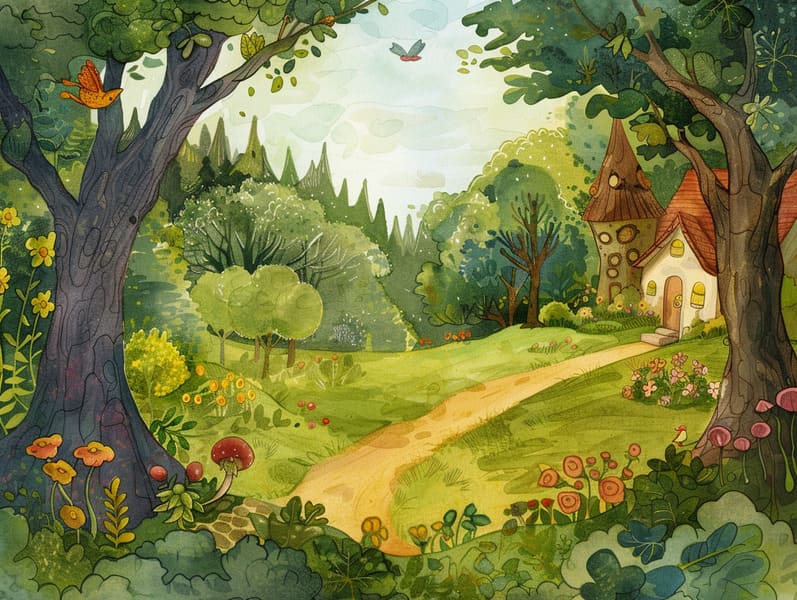The Birth of Children's Fairy Tales and Their Unchanging Radiance.
The Birth of Children's Fairy Tales and Their Unchanging Radiance.
Blog Article

Children's fairy tales have long histories. These tales have been recounted from one generation to the next long before they were ever recorded. They emerged from a variety of civilizations, including Asian traditions. They were initially conveyed among older generations, often carrying themes and messages relevant to the societal norms and beliefs of the time.
The renowned Brothers Grimm, Jacob and Wilhelm, were among the first to compile and publish many of these beloved narratives. Their published works, "Grimm's Fairy Stories," included stories like "The Little Glass Slipper," "Hansel and Grethel," and "Snow-White and Rose-Red," which have since become hallmarks in the world of beloved fairy tales. Similarly, H. C. Andersen's fanciful tales, such as "The Mermaid's Tale," and "The Little Duckling," have floated into hearts worldwide, solidifying their place in the pantheon of iconic fairy tales.
Though they are centuries old, fairy tales remain as pertinent as ever, especially as kids' bedtime tales. These delightful tales are now available in different formats, including gorgeously illustrated books, fantastical animations, and online storybooks.
Their enduring popularity can be ascribed to several enchanting factors:
Ethical Lessons: Traditional fairy tales often whisper important moral lessons. Tales like "The Tale of the Boy Who Cried Wolf" teach the importance of truth, while "The Tortoise and the Hare" demonstrate the values of resolve and modesty. These narratives offer the young clear distinctions between ethical and unethical, building their moral compass in a tender yet important way.
Compassion and Knowledge: Fairy tales frequently involve characters facing challenges and problems, encouraging young listeners to understand with their struggles and support their triumphs. For instance, "Beauty and Her Beast" teaches us the virtue of valuing inner qualities to know the true character of a character, nurturing empathy and comprehension.
Cultural Awareness: Many traditional fairy tales are interwoven with the cultural contexts from which they grew. Immersing in these stories can provide enlightening views into different ways of life, developing a sense of global awareness and appreciation.
Creativity and Fantasy: The magical elements in traditional fairy tales—supernatural elements—revitalize children’s creative dreams. These stories bring readers to enchanted realms, revitalizing imaginative dreams and a sense of awe that lasts a lifetime.
Classic fairy tales are not only fascinating but also pedagogical. They function get more info as whimsical tools in promoting various thinking and feeling skills in the young. When old fairy tales are spoken out loud, they advance language development by introducing new vocabulary and complex sentence structures. This practice also nurtures hearing abilities and attention span, as kids concentrate deeply, keen to see what happens next.
Furthermore, exploring the themes and characters of old fairy tales can cultivate logical thinking and critical thinking. Young readers are led to detect patterns, foresee events, and comprehend cause and effect. These contemplations also further children communicate their thoughts and feelings, advancing their emotional intelligence.
In today’s technological era, the existence of online fairy tales has made these tales more accessible than ever. Online platforms and web apps supply ample collections of classic fairy tales that can be experienced or listened on anytime, anywhere. Fairy tales recited are particularly favored, extending an charming way for little ones to enjoy these whimsical stories. Narrated books and read-to-me stories transport characters and settings to life, often paired with delightful audio effects and instrumentals that raise the narrative journey.
The everlasting appeal of traditional fairy tales lies in their ability to change to new eras while retaining their central messages. Contemporary retellings of these stories often feature more different figures and modern settings, making them meaningful to today’s audience. However, the main ideas of fearlessness, warmth, and lawfulness remain unchanged, continuing to affect children of all ages.
Traditional fairy tales also offer a sense of assurance and familiarity. They impart a coherent narrative with a obvious beginning, middle, and end, often finishing with the closure of conflicts and the triumph of morality over immorality. This certainty can be reassuring for the young, delivering a sense of stability in an dynamic world.
Timeless fairy tales continue to captivate and educate new generations, maintaining their attraction and pertinence in modern society. As kids' bedtime tales, they serve a perfect blend of captivation and insight, supporting moral values, empathy, and creativity. The abundance of internet fairy tales and the commonness of fairy tales told out loud assure that these old narratives remain within reach to new generations.
By defending and releasing these tales, we continue to acknowledge the rich tapestry of narrative artistry and cultural heritage. Whether you are reading a richly illustrated book, discovering a virtual library, or listening to an read-aloud story, the attraction of Grimm's fairy tales is always within reach. These fairy tales demonstrate of the ageless influence of fairy tales and its ability to join us across centuries and lands.
If you are reading a vibrantly illustrated book, browsing a digital library, or listening through an spoken story, the delight of ancient fairy tales is always within reach.
These stories emphasize of the consistent magic of storytelling and its ability to tie us across epochs and places, establishing a link that fascinates and enlightens alike.